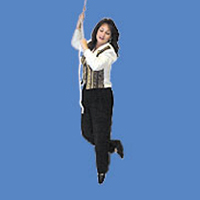
In the 1957 science fiction film The Incredible Shrinking Man, the actor Grant Williams had to appear to shrink in size daily. Part of the film were made by building giant-sized sets, complete with outsized armchairs and tables. But in some scenes, as when Williams is chased by his cat – gigantic in comparison to him – a process called travelling matte was used.
In a similar way to a stationary matte painting, travelling matte involves creating a ‘hole’ in a film background, so that separately filmed action can be superimposed. But the travelling matte ‘hole’ has to shift position or change in size from frame to frame, to match the area wherever the actors or vehicles are required to move.
The system was used extensively in the Superman films, especially when Superman was required to fly long distances o to recede to a very small size.
The most commonly used method is the ‘blue screen’ process. actors, miniatures or other objects are filmed before a blue screen and the colour negative is then printed onto a black-and-white master, which captures only the blue area. The result is a film in which the background is clear, while the foreground action appears in silhouette.
This is the travelling matte. It is then run through an optical camera to mask the unwanted foreground, while the background film is exposed.
Thin blue line
This process is next reversed to mask the background when the foreground action is added to the negative. The film then contains both foreground and background footage combined on each frame.
Sometimes, a thin blue line or fringe is visible around the outline of the actor or model. But modern optical-effects technicians can now eliminate the line, which was caused by reflected light from the blue background screen.
Another – yet more laborious – method of creating a travelling matte was used by Stanley Kubrick for his spectacular film 2001: A Space Odyssey.
To superimpose film of space vehicles on that of backgrounds of stars would have resulted in the stars also showing up the images of the spaceships. To solve the problem, Kubrick needed to have spaceship-shaped holes that would move backgrounds – holes that would move around to match the movements of the various craft.
The oldest, most time consuming and costly method of creating travelling mattes was resorted to: painting spaceship silhouettes onto hundreds upon hundreds of frames of film.
Picture Credit : Google

